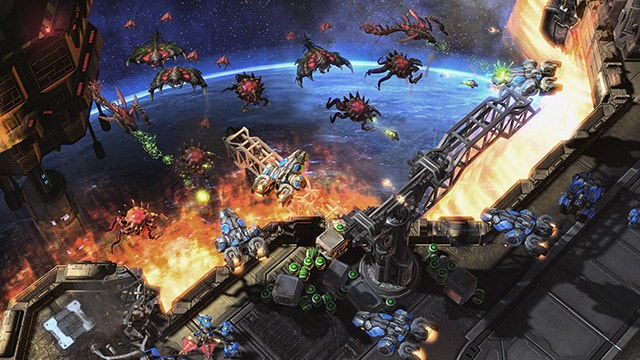StarCraft: A Deep Dive into a Legendary RTS
StarCraft is a military science fiction real-time strategy (RTS) game developed and published by Blizzard Entertainment. Released in 1998, it’s considered one of the most important and influential games in the history of the genre, and even gaming as a whole. Here’s a comprehensive overview, covering its history, gameplay, factions, legacy, and current state:
1. History & Development
- Origins (1998): Developed by SMTV (later acquired by Blizzard), StarCraft was designed to be a more complex and strategic RTS than existing titles like Command & Conquer. It drew inspiration from science fiction authors like Isaac Asimov and Frank Herbert.
- Brood War Expansion (1998): This expansion pack added a significant amount of content, including new units, maps, and a compelling continuation of the story. It’s often considered integral to the core StarCraft experience.
- Remastered (2017): Blizzard released StarCraft: Remastered, updating the graphics, audio, and online infrastructure while preserving the core gameplay. This brought the classic game to modern platforms and resolutions.
- StarCraft II (2010-2017): A sequel that built upon the foundation of the original, with improved graphics, a more robust campaign, and a redesigned online battle.net system. It was released in three parts: Wings of Liberty, Heart of the Swarm, and Legacy of the Void.
2. Gameplay
- Real-Time Strategy: Players control one of three distinct races, gathering resources, building bases, creating armies, and ultimately defeating their opponents.
- Resource Management: Two primary resources are crucial:
- Minerals: Gathered by worker units (SCVs, Drones, Probes) from mineral patches. Used for most building and unit production.
- Vespene Gas: Extracted by worker units from Vespene Geysers. Required for advanced units and technologies.
- Base Building: Establishing a strong base is vital. This involves constructing structures for resource gathering, unit production, research, and defense.
- Unit Control & Micro-Management: Effective unit control is key. This includes positioning, targeting, using abilities, and reacting to enemy movements. “Micro” refers to precise control of individual units, while “macro” refers to overall base management and resource allocation.
- Technology Tree: Each race has a unique technology tree, allowing players to research upgrades that enhance their units and unlock new abilities.
- Fog of War: Areas of the map not explored by your units are hidden, adding an element of scouting and strategic uncertainty.
3. The Three Races
Each race has a unique playstyle, strengths, and weaknesses:
- Terran: (Humans)
- Strengths: Versatile, adaptable, strong defensive capabilities, can “lift off” buildings for relocation.
- Playstyle: Often focuses on strong defensive positions, mobile armies, and utilizing mech units (tanks, siege units).
- Key Units: Marine, Marauder*, Siege Tank, Battlecruiser, SCV.
- Zerg: (Insectoid Swarm)
- Strengths: Rapid expansion, overwhelming numbers, powerful late-game units, can “creep” spread to increase movement speed.
- Playstyle: Aggressive, relies on swarming tactics, quick expansion, and overwhelming the enemy with sheer numbers.
- Key Units: Zergling, Hydralisk, Mutalisk, Ultralisk, Drone.
- Protoss: (Advanced Alien Race)
- Strengths: Powerful, technologically advanced units, strong shields, can “warp in” units directly to bases.
- Playstyle: Relies on powerful, high-tech units, strategic positioning, and utilizing warp gates for rapid reinforcement.
- Key Units: Zealot, Stalker*, Immortal*, Colossus*, Probe.
Note: Units marked with an asterisk(*) appear in StarCraft II.
4. Legacy & Impact
- eSports Pioneer: StarCraft, particularly Brood War, was a massive eSport in South Korea, with professional players achieving celebrity status. It helped establish the foundations for modern eSports.
- Strategic Depth: The game’s complex mechanics and strategic possibilities have made it a favorite among competitive gamers.
- Cultural Impact: StarCraft has influenced other games, movies, and even military strategy.
- Modding Community: A vibrant modding community has created custom maps, campaigns, and game modes, extending the game’s lifespan.
- Influence on RTS Genre: StarCraft set a high bar for RTS games, influencing the design of many subsequent titles.
5. Current State (2024)
- StarCraft: Remastered: Still actively played by a dedicated community, primarily focused on the classic Brood War experience. Blizzard continues to provide updates and support.
- StarCraft II: While Blizzard has largely ended active development on StarCraft II, the game remains playable and has a dedicated player base. The game is now free-to-play, with certain aspects (campaigns, co-op commanders) available for purchase.
- Competitive Scene: While the competitive scene isn’t as large as it once was, there are still tournaments and leagues for both Brood War and StarCraft II.
- Accessibility: StarCraft II’s free-to-play model makes it more accessible to new players.
Where to Learn More
- Official StarCraft Website: https://starcraft.blizzard.com/
- Liquipedia (StarCraft Wiki): https://liquipedia.net/starcraft/Main_Page
- TeamLiquid (Community Site): https://www.teamliquidpro.com/
- YouTube Channels: Search for “StarCraft” on YouTube for tutorials, gameplay videos, and tournament coverage. (e.g., LowkoTV, Rotterdam)
StarCraft is more than just a game; it’s a cultural phenomenon that has left an indelible mark on the gaming world. Its strategic depth, compelling story, and competitive scene continue to attract players and inspire awe decades after its initial release. Whether you’re a seasoned RTS veteran or a curious newcomer, StarCraft offers a challenging and rewarding experience.
